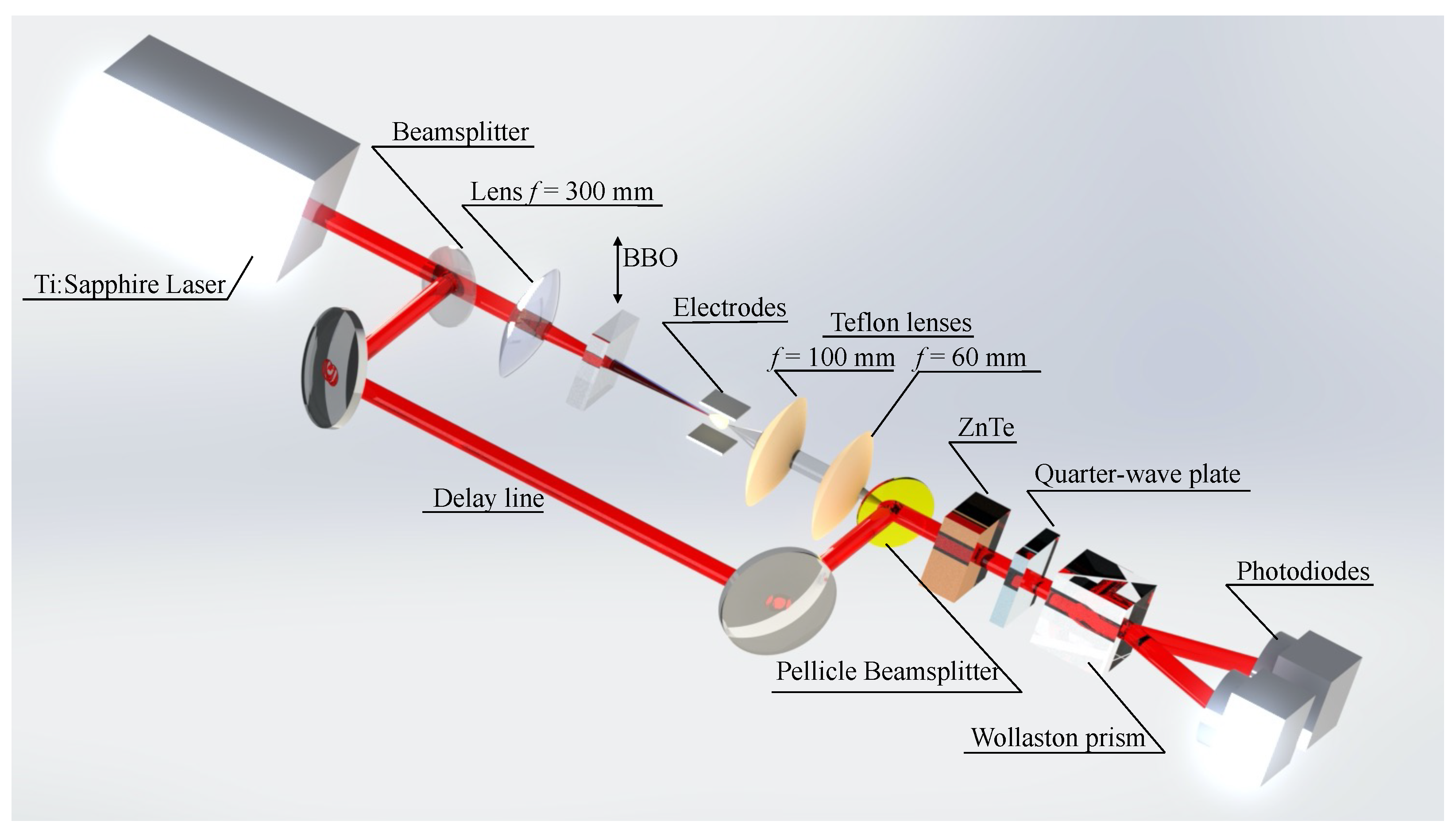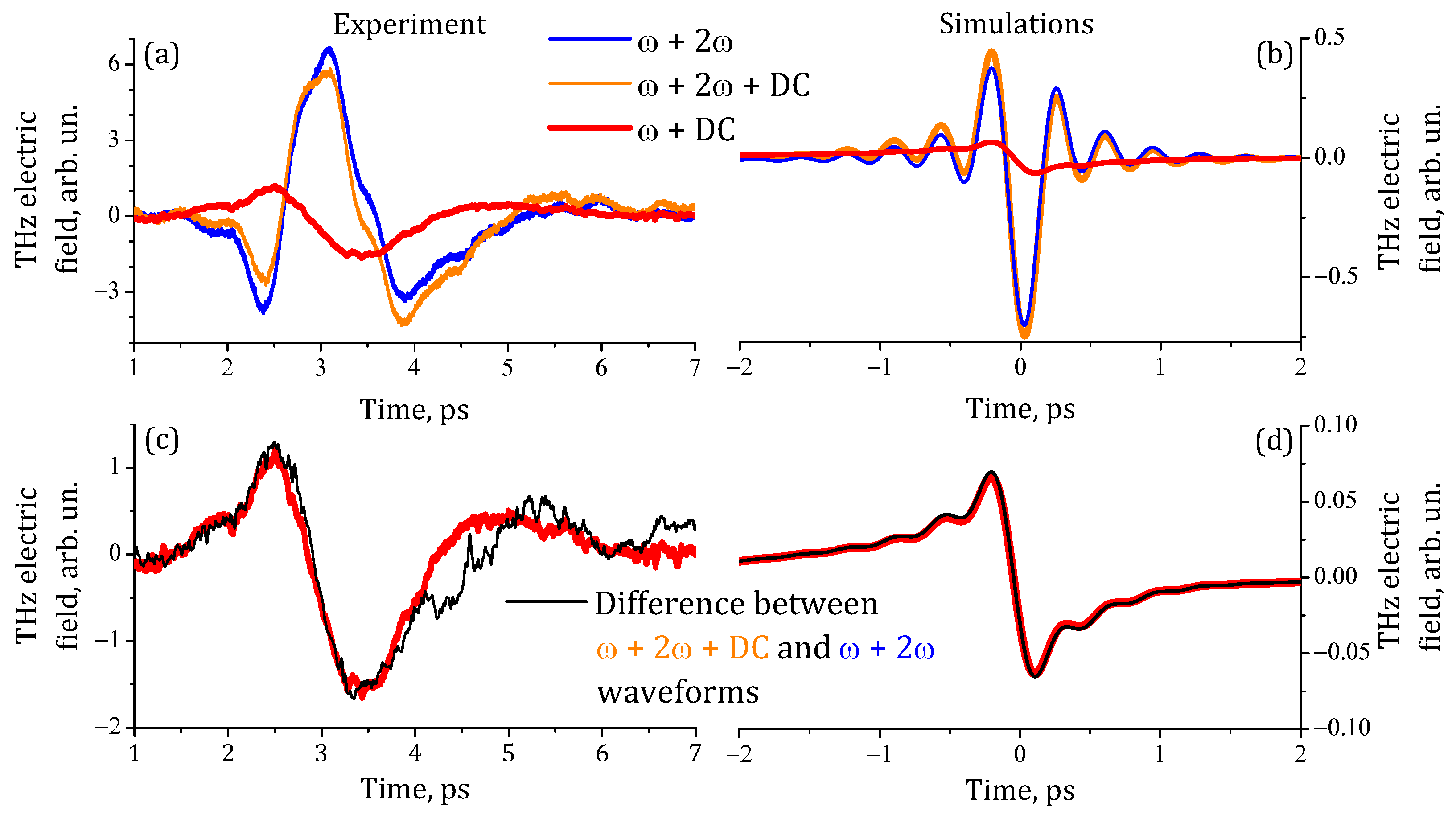Superposition of 2ω and Electrostatic Field Induced Terahertz Waveforms in DC-Biased Two-Color Filament
Abstract
:1. Introduction
2. Materials and Methods
2.1. Experimental Setup
| (a) = : | DC-biased single-color filament, when BBO crystal was removed from the optical path; |
| (b) = : | two-color filament, when the voltage on the electrodes was turned off (); |
| (c) = : | DC-biased two-color filament. |
2.2. Simulations
3. Results and Discussion
4. Conclusions
Author Contributions
Funding
Institutional Review Board Statement
Informed Consent Statement
Data Availability Statement
Conflicts of Interest
References
- Liu, W.; Chin, S.L. Direct measurement of the critical power of femtosecond Ti: Sapphire laser pulse in air. Opt. Express 2005, 13, 5750–5755. [Google Scholar] [CrossRef] [PubMed]
- Couairon, A.; Mysyrowicz, A. Femtosecond filamentation in transparent media. Phys. Rep. 2007, 441, 47–189. [Google Scholar] [CrossRef]
- Bergé, L.; Skupin, S.; Nuter, R.; Kasparian, J.; Wolf, J.P. Ultrashort filaments of light in weakly ionized, optically transparent media. Rep. Prog. Phys. 2007, 70, 1633–1713. [Google Scholar] [CrossRef] [Green Version]
- Zhang, X.C.; Xu, J. Introduction to THz Wave Photonics; Springer: New York, NY, USA, 2010; Volume 29. [Google Scholar]
- Zhang, X.C.; Shkurinov, A.; Zhang, Y. Extreme terahertz science. Nat. Photonics 2017, 11, 16. [Google Scholar] [CrossRef]
- Hamster, H.; Sullivan, A.; Gordon, S.; White, W.; Falcone, R. Subpicosecond, electromagnetic pulses from intense laser-plasma interaction. Phys. Rev. Lett. 1993, 71, 2725. [Google Scholar] [CrossRef] [PubMed]
- D’Amico, C.; Houard, A.; Franco, M.; Prade, B.; Mysyrowicz, A.; Couairon, A.; Tikhonchuk, V. Conical forward THz emission from femtosecond-laser-beam filamentation in air. Phys. Rev. Lett. 2007, 98, 235002. [Google Scholar] [CrossRef] [Green Version]
- Löffler, T.; Jacob, F.; Roskos, H. Generation of terahertz pulses by photoionization of electrically biased air. Appl. Phys. Lett. 2000, 77, 453–455. [Google Scholar] [CrossRef]
- Cook, D.; Hochstrasser, R. Intense terahertz pulses by four-wave rectification in air. Opt. Lett. 2000, 25, 1210–1212. [Google Scholar] [CrossRef]
- Zhang, L.L.; Wang, W.M.; Wu, T.; Zhang, R.; Zhang, S.J.; Zhang, C.L.; Zhang, Y.; Sheng, Z.M.; Zhang, X.C. Observation of terahertz radiation via the two-color laser scheme with uncommon frequency ratios. Phys. Rev. Lett. 2017, 119, 235001. [Google Scholar] [CrossRef] [PubMed] [Green Version]
- Bergé, L.; Kaltenecker, K.; Engelbrecht, S.; Nguyen, A.; Skupin, S.; Merlat, L.; Fischer, B.; Zhou, B.; Thiele, I.; Jepsen, P.U. Terahertz spectroscopy from air plasmas created by two-color femtosecond laser pulses: The ALTESSE project. Epl 2019, 126, 24001. [Google Scholar] [CrossRef] [Green Version]
- Trofimov, V.A.; Wang, N.N.; Qiu, J.H.; Varentsova, S.A. Role of the pulse duration at measurements of spectral signatures of substances in THz range of frequencies. In Proceedings of the Millimetre Wave and Terahertz Sensors and Technology XII, Strasbourg, France, 9–12 September 2019; SPIE, the International Society for Optics and Photonics: Bellingham, WA, USA, 2019; Volume 11164, p. 1116405. [Google Scholar]
- Houard, A.; Liu, Y.; Prade, B.; Tikhonchuk, V.T.; Mysyrowicz, A. Strong enhancement of terahertz radiation from laser filaments in air by a static electric field. Phys. Rev. Lett. 2008, 100, 255006. [Google Scholar] [CrossRef] [PubMed] [Green Version]
- Kosareva, O.; Esaulkov, M.; Panov, N.; Andreeva, V.; Shipilo, D.; Solyankin, P.; Demircan, A.; Babushkin, I.; Makarov, V.; Morgner, U.; et al. Polarization control of terahertz radiation from two-color femtosecond gas breakdown plasma. Opt. Lett. 2018, 43, 90–93. [Google Scholar] [CrossRef]
- Wang, T.J.; Marceau, C.; Chen, Y.; Yuan, S.; Théberge, F.; Châteauneuf, M.; Dubois, J.; Chin, S.L. Terahertz emission from a dc-biased two-color femtosecond laser-induced filament in air. Appl. Phys. Lett. 2010, 96, 211113. [Google Scholar] [CrossRef]
- Nikolaeva, I.; Shipilo, D.; Panov, N.; Kosareva, O. Dual-wavelength filamentation with a fraction of fundamental laser frequency as a wideband THz source. Laser Phys. Lett. 2021, 18, 025401. [Google Scholar] [CrossRef]
- Clerici, M.; Peccianti, M.; Schmidt, B.E.; Caspani, L.; Shalaby, M.; Giguere, M.; Lotti, A.; Couairon, A.; Légaré, F.; Ozaki, T.; et al. Wavelength scaling of terahertz generation by gas ionization. Phys. Rev. Lett. 2013, 110, 253901. [Google Scholar] [CrossRef] [Green Version]
- Jang, D.; Schwartz, R.M.; Woodbury, D.; Griff-McMahon, J.; Younis, A.H.; Milchberg, H.M.; Kim, K.Y. Efficient terahertz and Brunel harmonic generation from air plasma via mid-infrared coherent control. Optica 2019, 6, 1338. [Google Scholar] [CrossRef]
- Mitrofanov, A.; Sidorov-Biryukov, D.; Nazarov, M.; Voronin, A.; Rozhko, M.; Shutov, A.; Ryabchuk, S.; Serebryannikov, E.; Fedotov, A.; Zheltikov, A. Ultraviolet-to-millimeter-band supercontinua driven by ultrashort mid-infrared laser pulses. Optica 2020, 7, 15. [Google Scholar] [CrossRef]
- Koulouklidis, A.D.; Gollner, C.; Shumakova, V.; Fedorov, V.Y.; Pugžlys, A.; Baltuška, A.; Tzortzakis, S. Observation of extremely efficient terahertz generation from mid-infrared two-color laser filaments. Nat. Commun. 2020, 11, 1. [Google Scholar] [CrossRef] [Green Version]
- Akhmedzhanov, R.; Ilyakov, I.; Mironov, V.; Suvorov, E.; Fadeev, D.; Shishkin, B. Plasma mechanisms of pulsed terahertz radiation generation. Radiophys. Quantum Electron. 2009, 52, 482–493. [Google Scholar] [CrossRef]
- Suvorov, E.; Akhmedzhanov, R.; Fadeev, D.; Ilyakov, I.; Mironov, V.; Shishkin, B. On the peculiarities of THz radiation generation in a laser induced plasmas. J. Infrared Millim. Terahertz Waves 2011, 32, 1243–1252. [Google Scholar] [CrossRef]
- Feng, S.; Dong, L.; Tan, Y.; Wu, T.; Ma, D.; Zhang, L.; Zhang, C.; Zhao, Y. Observation on the competition mechanism of terahertz wave generation from filament in bias electric field. Opt. Commun. 2020, 473, 125917. [Google Scholar] [CrossRef]
- Thomson, M.D.; Kreß, M.; Löffler, T.; Roskos, H.G. Broadband THz emission from gas plasmas induced by femtosecond optical pulses: From fundamentals to applications. Las. Photon. Rev. 2007, 1, 349–368. [Google Scholar]
- Zhang, Z.; Chen, Y.; Zhang, Z.; Xia, T.; Zhang, J.; Sheng, Z. Frequency blue shift of terahertz radiation from femtosecond laser induced air plasmas. Appl. Phys. B 2021, 127, 1–5. [Google Scholar] [CrossRef]
- Dey, I.; Jana, K.; Fedorov, V.Y.; Koulouklidis, A.D.; Mondal, A.; Shaikh, M.; Sarkar, D.; Lad, A.D.; Tzortzakis, S.; Couairon, A.; et al. Highly efficient broadband terahertz generation from ultrashort laser filamentation in liquids. Nat. Commun. 2017, 8, 1184. [Google Scholar] [CrossRef] [PubMed]
- Kolesik, M.; Moloney, J.V. Nonlinear optical pulse propagation simulation: From Maxwell’s to unidirectional equations. Phys. Rev. E 2004, 70, 036604. [Google Scholar] [CrossRef]
- Auston, D.H.; Cheung, K.P.; Smith, P.R. Picosecond photoconducting Hertzian dipoles. Appl. Phys. Lett. 1984, 45, 284–286. [Google Scholar] [CrossRef]
- Smith, P.R.; Auston, D.H.; Nuss, M.C. Subpicosecond photoconducting dipole antennas. IEEE J. Quantum Electron. 1988, 24, 255–260. [Google Scholar] [CrossRef]
- Dai, J.; Xie, X.; Zhang, X.C. Detection of broadband terahertz waves with a laser-induced plasma in gases. Phys. Rev. Lett. 2006, 97, 103903. [Google Scholar] [CrossRef]
- Wu, Q.; Zhang, X.C. Free-space electro-optic sampling of terahertz beams. Appl. Phys. Lett. 1995, 67, 3523–3525. [Google Scholar] [CrossRef]
- Kostin, V.A.; Laryushin, I.D.; Silaev, A.A.; Vvedenskii, N.V. Ionization-Induced Multiwave Mixing: Terahertz Generation with Two-Color Laser Pulses of Various Frequency Ratios. Phys. Rev. Lett. 2016, 117, 035003. [Google Scholar] [CrossRef]
- Lindberg, M.; Koch, S.W. Effective Bloch equations for semiconductors. Phys. Rev. B 1988, 38, 3342. [Google Scholar] [CrossRef]
- Bergé, L.; Skupin, S.; Köhler, C.; Babushkin, I.; Herrmann, J. 3D Numerical Simulations of THz Generation by Two-Color Laser Filaments. Phys. Rev. Lett. 2013, 110, 073901. [Google Scholar] [CrossRef] [PubMed]
- Citroni, R.; Di Paolo, F.; Di Carlo, A. Replacing noble metals with alternative metals in MID-IR frequency: A theoretical approach. In Proceedings of the AIP Conference NANOINNOVATION 2017, Rome, Italy, 26–29 September 2017; AIP Pullishing LLC: College Park, MD, USA, 2018; Volume 1990, p. 020004. [Google Scholar]
- Nikolaeva, I.; Shipilo, D.; Pushkarev, D.; Rizaev, G.; Mokrousova, D.; Koribut, A.; Grudtsyn, Y.; Panov, N.; Seleznev, L.; Liu, W.; et al. Flat-top THz directional diagram of a DC-biased filament. Opt. Lett. 2021, 46, 5497–5500. [Google Scholar] [CrossRef]
- Rae, S.; Burnett, K. Detailed simulations of plasma-induced spectral blueshifting. Phys. Rev. A 1992, 46, 1084. [Google Scholar] [CrossRef]
- Zhang, Z.; Panov, N.; Andreeva, V.; Zhang, Z.; Slepkov, A.; Shipilo, D.; Thomson, M.; Wang, T.J.; Babushkin, I.; Demircan, A.; et al. Optimum chirp for efficient terahertz generation from two-color femtosecond pulses in air. Appl. Phys. Lett. 2018, 113, 241103. [Google Scholar] [CrossRef]
- Chen, Y.; Wang, T.j.; Marceau, C.; Théberge, F.; Châteauneuf, M.; Dubois, J.; Kosareva, O.; Chin, S.L. Characterization of terahertz emission from a dc-biased filament in air. Appl. Phys. Lett. 2009, 95, 101101. [Google Scholar] [CrossRef]
- Gallot, G.; Zhang, J.; McGowan, R.; Jeon, T.I.; Grischkowsky, D. Measurements of the THz absorption and dispersion of ZnTe and their relevance to the electro-optic detection of THz radiation. Appl. Phys. Lett. 1999, 74, 3450–3452. [Google Scholar] [CrossRef] [Green Version]
- Borodin, A.V.; Panov, N.A.; Kosareva, O.G.; Andreeva, V.A.; Esaulkov, M.N.; Makarov, V.A.; Shkurinov, A.P.; Chin, S.L.; Zhang, X.C. Transformation of terahertz spectra emitted from dual-frequency femtosecond pulse interaction in gases. Opt. Lett. 2013, 38, 1906–1908. [Google Scholar] [CrossRef]
- Kim, K.Y.; Glownia, J.H.; Taylor, A.J.; Rodriguez, G. Terahertz emission from ultrafast ionizing air in symmetry-broken laser fields. Opt. Express 2007, 15, 4577–4584. [Google Scholar] [CrossRef] [PubMed]




Publisher’s Note: MDPI stays neutral with regard to jurisdictional claims in published maps and institutional affiliations. |
© 2021 by the authors. Licensee MDPI, Basel, Switzerland. This article is an open access article distributed under the terms and conditions of the Creative Commons Attribution (CC BY) license (https://creativecommons.org/licenses/by/4.0/).
Share and Cite
Ushakov, A.; Chizhov, P.; Nikolaeva, I.; Shipilo, D.; Panov, N.; Bukin, V.; Mamaeva, K.; Kosareva, O.; Garnov, S. Superposition of 2ω and Electrostatic Field Induced Terahertz Waveforms in DC-Biased Two-Color Filament. Appl. Sci. 2021, 11, 11888. https://doi.org/10.3390/app112411888
Ushakov A, Chizhov P, Nikolaeva I, Shipilo D, Panov N, Bukin V, Mamaeva K, Kosareva O, Garnov S. Superposition of 2ω and Electrostatic Field Induced Terahertz Waveforms in DC-Biased Two-Color Filament. Applied Sciences. 2021; 11(24):11888. https://doi.org/10.3390/app112411888
Chicago/Turabian StyleUshakov, Aleksandr, Pavel Chizhov, Irina Nikolaeva, Daniil Shipilo, Nikolay Panov, Vladimir Bukin, Kseniia Mamaeva, Olga Kosareva, and Sergey Garnov. 2021. "Superposition of 2ω and Electrostatic Field Induced Terahertz Waveforms in DC-Biased Two-Color Filament" Applied Sciences 11, no. 24: 11888. https://doi.org/10.3390/app112411888
APA StyleUshakov, A., Chizhov, P., Nikolaeva, I., Shipilo, D., Panov, N., Bukin, V., Mamaeva, K., Kosareva, O., & Garnov, S. (2021). Superposition of 2ω and Electrostatic Field Induced Terahertz Waveforms in DC-Biased Two-Color Filament. Applied Sciences, 11(24), 11888. https://doi.org/10.3390/app112411888






